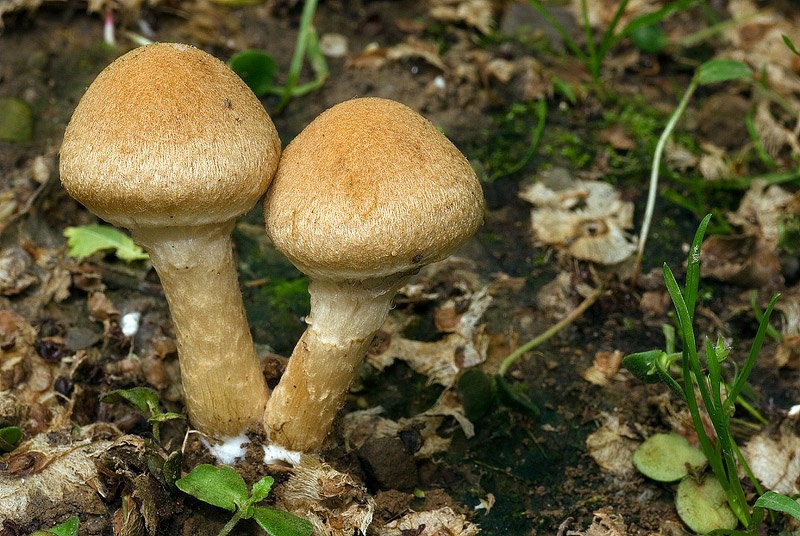មាតិកា
Psatyrella velvety (Psathyrella lacrymabunda)
- ផ្នែក៖ Basidiomycota (Basidiomycetes)
- ផ្នែករង៖ អាហ្គារីកូម៉ីកូទីណា (Agaricomycetes)
- ថ្នាក់៖ Agaricomycetes (Agaricomycetes)
- ប្រភេទរង៖ Agaricomycetidae (Agaricomycetes)
- លំដាប់: Agaricales (Agaric ឬ Lamellar)
- គ្រួសារ៖ Psathyrellaceae (Psatyrellaceae)
- ពូជ៖ Psathyrella (Psatyrella)
- ប្រភេទ: Psathyrella lacrymabunda (Psathyrella velvety)
- Lacrimaria velvety;
- Lacrimaria felt;
- Psathyrella velutina;
- Lacrimaria tearful;
- Lacrimaria velvety.

ការពិពណ៌នាខាងក្រៅ
The fruiting body of the velvety psatirella is hat-legged. The caps of this fungus are 3-8 cm in diameter, in young mushrooms they are hemispherical, sometimes bell-shaped. In mature mushrooms, the cap becomes convex-prostrate, velvety to the touch, along the edges of the cap, the remains of the bedspread are clearly visible. The flesh of the cap is fibrous and scaly. Sometimes the caps of the velvety psatirella are radially wrinkled, they can be brownish-red, yellow-brown or ocher-brown in color. The middle of these mushrooms has a chestnut-brown color.
The leg of the velvety psatirella can be from 2 to 10 cm in length, and does not exceed 1 cm in diameter. The shape of the leg is predominantly cylindrical. From the inside, the leg is empty, slightly expanded at the base. Its structure is fibrous-felt, and the color is off-white. The fibers are brown in color. Young mushrooms have a parapedic ring, which disappears over time.
Mushroom pulp has a whitish color, sometimes giving off yellow. At the base of the leg, the flesh is brown. In general, the pulp of this type of mushroom is brittle, saturated with moisture.
The hymenophore of the velvety psatirella is lamellar. The plates located under the cap adhere to the surface of the leg, have a grayish tint and are often located. In mature fruiting bodies, the plates become dark brown, almost black, and necessarily have light edges. In immature fruiting bodies, droplets appear on the plates.
The spore powder of velvety psatirella has a brown-violet color. The spores are lemon-shaped, warty.
រដូវ Grebe និងជម្រក
Fruiting of the velvety psatyrella (Psathyrella lacrymabunda) begins in July, when single mushrooms of this species appear, and its activity increases significantly in August and continues until early September.
From mid-summer until about October, the velvety psatirella can be found in mixed, deciduous and open places, on soils (more often sandy), in grass, near roadsides, on rotten wood, near forest paths and roads, in parks and squares, in gardens and cemeteries. It is not often possible to meet mushrooms of this type in Our Country. Velvety psatirells grow in groups or singly.
ភាពងាយស្រួល
Psatirella velvety belongs to the number of conditionally edible mushrooms. It is recommended to use it fresh for cooking second courses. This mushroom is boiled for 15 minutes, and the broth is poured out. However, some experts in the field of mushroom growing believe that velvety psatirrella are inedible and highly poisonous mushrooms.
ប្រភេទស្រដៀងគ្នានិងភាពខុសគ្នាពីពួកគេ។
In appearance, the velvety psatyrella (Psathyrella lacrymabunda) is similar to the cotton psatyrella (Psathyrella cotonea). However, the second type of mushroom has a lighter shade, and is whitish when unripe. Cotton psatirrella grow mainly on rotting wood, characterized by a hymenophore with red-brown plates.
ព័ត៌មានផ្សេងទៀតអំពីផ្សិត
Psatirella velvety is sometimes referred to as an independent genus of mushrooms Lacrimaria (Lacrymaria), which is translated from Latin as “tear”. This name was given to the fungus because in young fruiting bodies, droplets of liquid, very similar to tears, often accumulate on the plates of the hymenophore.









